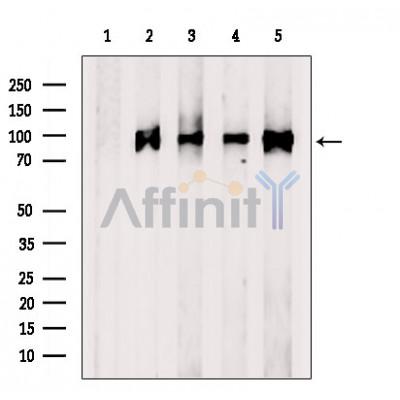CRACR2A Antibody - #DF12914
| Product: | CRACR2A Antibody |
| Catalog: | DF12914 |
| Description: | Rabbit polyclonal antibody to CRACR2A |
| Application: | WB |
| Reactivity: | Human, Mouse, Monkey |
| Prediction: | Rabbit |
| Mol.Wt.: | 46 kDa, 90 kDa; 46kD(Calculated). |
| Uniprot: | Q9BSW2 |
| RRID: | AB_2845875 |
Related Downloads
Protocols
Product Info
*The optimal dilutions should be determined by the end user. For optimal experimental results, antibody reuse is not recommended.
*Tips:
WB: For western blot detection of denatured protein samples. IHC: For immunohistochemical detection of paraffin sections (IHC-p) or frozen sections (IHC-f) of tissue samples. IF/ICC: For immunofluorescence detection of cell samples. ELISA(peptide): For ELISA detection of antigenic peptide.
Cite Format: Affinity Biosciences Cat# DF12914, RRID:AB_2845875.
Fold/Unfold
Calcium release-activated calcium channel regulator 2A; CRAC channel regulator 2A; CRACR2A; EF hand calcium binding domain 4B; EF hand calcium binding domain containing protein 4B; EF-hand calcium-binding domain-containing protein 4B; EFC4B_HUMAN; EFCAB 4B; Efcab4b; FLJ33805; MGC4266;
Immunogens
A synthesized peptide derived from human CRACR2A, corresponding to a region within N-terminal amino acids.
- Q9BSW2 EFC4B_HUMAN:
- Protein BLAST With
- NCBI/
- ExPASy/
- Uniprot
MAAPDGRVVSRPQRLGQGSGQGPKGSGACLHPLDSLEQKETQEQTSGQLVMLRKAQEFFQTCDAEGKGFIARKDMQRLHKELPLSLEELEDVFDALDADGNGYLTPQEFTTGFSHFFFSQNNPSQEDAGEQVAQRHEEKVYLSRGDEDLGDMGEDEEAQFRMLMDRLGAQKVLEDESDVKQLWLQLKKEEPHLLSNFEDFLTRIISQLQEAHEEKNELECALKRKIAAYDEEIQHLYEEMEQQIKSEKEQFLLKDTERFQARSQELEQKLLCKEQELEQLTQKQKRLEGQCTALHHDKHETKAENTKLKLTNQELARELERTSWELQDAQQQLESLQQEACKLHQEKEMEVYRVTESLQREKAGLLKQLDFLRCVGGHWPVLRAPPRSLGSEGPV
Predictions
Score>80(red) has high confidence and is suggested to be used for WB detection. *The prediction model is mainly based on the alignment of immunogen sequences, the results are for reference only, not as the basis of quality assurance.
High(score>80) Medium(80>score>50) Low(score<50) No confidence
Research Backgrounds
Ca(2+)-binding protein that plays a key role in store-operated Ca(2+) entry (SOCE) in T-cells by regulating CRAC channel activation. Acts as a cytoplasmic calcium-sensor that facilitates the clustering of ORAI1 and STIM1 at the junctional regions between the plasma membrane and the endoplasmic reticulum upon low Ca(2+) concentration. It thereby regulates CRAC channel activation, including translocation and clustering of ORAI1 and STIM1. Upon increase of cytoplasmic Ca(2+) resulting from opening of CRAC channels, dissociates from ORAI1 and STIM1, thereby destabilizing the ORAI1-STIM1 complex.
Cytoplasm.
Belongs to the EFCAB4 family.
Restrictive clause
Affinity Biosciences tests all products strictly. Citations are provided as a resource for additional applications that have not been validated by Affinity Biosciences. Please choose the appropriate format for each application and consult Materials and Methods sections for additional details about the use of any product in these publications.
For Research Use Only.
Not for use in diagnostic or therapeutic procedures. Not for resale. Not for distribution without written consent. Affinity Biosciences will not be held responsible for patent infringement or other violations that may occur with the use of our products. Affinity Biosciences, Affinity Biosciences Logo and all other trademarks are the property of Affinity Biosciences LTD.

